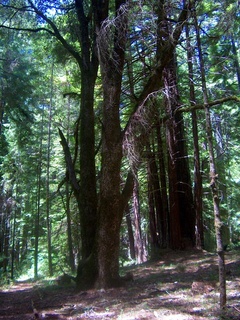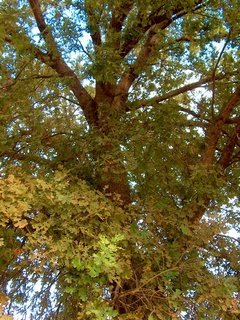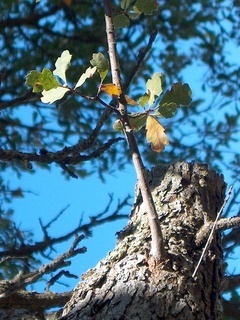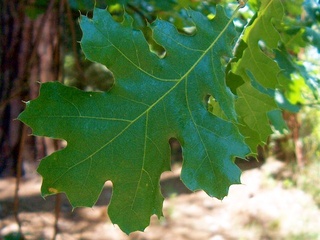Oaks are members of the Quercus and Lithocarpus genera of the beech family. Many of them are native to the Yuba-Sutter area. Four of these are evergreen (called "live oaks"), and the others are deciduous. Most are trees, but several are small enough to be considered shrubs.
Except for the tanbark oak, which is in a separate genus from the others, our native oaks can be classified into three subgenera of the genus Quercus: white oaks, red oaks, and intermediate oaks. White oaks have short styles and usually rounded, smooth leaf lobes. Their acorns mature in six months and taste sweet or slightly bitter. The insides of the acorn shells are hairless. Red oaks have long styles and usually sharp leaf lobes, with spiny bristles at the tips of the lobes. Their acorns mature in 18 months and taste very bitter. The insides of the acorn shells appear woolly. The actual nut is encased in a thin, clinging, papery skin. Intermediate oaks closely resemble red oaks, except that intermediate oaks have short styles.
Because oaks are the dominant tree in central oak woodland, which is the plant community native to most of Yuba and Sutter Counties, many of the native birds have evolved to depend primarily on oaks for food and shelter. Planting oak trees in your yard is an excellent way to attract rufous-crowned sparrows, oak titmice, lesser goldfinches, acorn woodpeckers, yellow-billed magpies, Nuttall's woodpeckers, white-breasted nuthatches, and Bewick's wrens—all of which are native to the Yuba-Sutter area.
Oaks are the larval host plants for the California sister, Propertius duskywing, mournful duskywing, golden hairstreak, and gold-hunter's hairstreak butterflies.
Evergreen
Interior Live Oak
 Interior live oak (Quercus wislizeni) can be recognized by its tendency to have some holly-shaped leaves and some smooth-edged leaves—often with both leaf shapes on a single branch, as shown here near the Marysville City Cemetery. Photo by queerbychoice. Interior live oak is a 10- to 30-foot-tall red oak shrub or small tree that is native to Yuba and Sutter Counties and typically grows at elevations below 6,500 feet. It is most often found on slopes and in valleys in central oak woodland.
Interior live oak (Quercus wislizeni) can be recognized by its tendency to have some holly-shaped leaves and some smooth-edged leaves—often with both leaf shapes on a single branch, as shown here near the Marysville City Cemetery. Photo by queerbychoice. Interior live oak is a 10- to 30-foot-tall red oak shrub or small tree that is native to Yuba and Sutter Counties and typically grows at elevations below 6,500 feet. It is most often found on slopes and in valleys in central oak woodland.
You can read more about it at the Theodore Payne Wiki and the Las Pilitas Nursery website. You can see pictures of it at CalPhotos, Flickr, and Picasa. You can find out where to buy it at the California Native Plant Link Exchange.
Canyon Live Oak
 Canyon live oak (Quercus chrysolepis). Photo by queerbychoice. Canyon live oak is a 30- to 90-foot-tall intermediate oak tree that is native to Yuba County and typically grows at elevations below 6,500 feet. It is most often found in canyons or on slopes in central oak woodland and yellow pine forest. It tolerates full shade.
Canyon live oak (Quercus chrysolepis). Photo by queerbychoice. Canyon live oak is a 30- to 90-foot-tall intermediate oak tree that is native to Yuba County and typically grows at elevations below 6,500 feet. It is most often found in canyons or on slopes in central oak woodland and yellow pine forest. It tolerates full shade.
You can read more about it at the Theodore Payne Wiki, the Las Pilitas Nursery website, and USDA Conservation Plant Characteristics. You can see pictures of it at CalPhotos, Flickr, and Picasa. You can find out where to buy it at the California Native Plant Link Exchange.
Coast Live Oak
Coast live oak is a 25- to 75-foot-tall red oak tree that is native to Sutter County and typically grows at elevations below 5,000 feet. It is most often found on slopes and in valleys in central oak woodland. It prefers full sun.
You can read more about it at the Theodore Payne Wiki, the Las Pilitas Nursery website, and USDA Conservation Plant Characteristics. You can see pictures of it at CalPhotos, Flickr, and Picasa. You can find out where to buy it at the California Native Plant Link Exchange.
Tanbark Oak
Tanbark oak (also called tanoak) is a 30- to 125-foot-tall shrub or tree that is native to Yuba County and typically grows at elevations below 8,000 feet. It is most often found on slopes in yellow pine forest. It prefers full sun.
You can read more about it at the Theodore Payne Wiki, the Las Pilitas Nursery website, and USDA Conservation Plant Characteristics. You can see pictures of it at CalPhotos, Flickr, and Picasa. You can find out where to buy it at the California Native Plant Link Exchange.
Deciduous
Valley Oak
 Valley oak (Quercus lobata) in Beckwourth Riverfront Park Complex. Photo by queerbychoice. Valley oak is a 35- to 100-foot-tall white oak tree that is native to Yuba and Sutter Counties and typically grows at elevations below 2,000 feet. It is most often found on slopes in central oak woodland. It prefers full sun. It is the primary larval host plant for the mournful duskywing butterfly.
Valley oak (Quercus lobata) in Beckwourth Riverfront Park Complex. Photo by queerbychoice. Valley oak is a 35- to 100-foot-tall white oak tree that is native to Yuba and Sutter Counties and typically grows at elevations below 2,000 feet. It is most often found on slopes in central oak woodland. It prefers full sun. It is the primary larval host plant for the mournful duskywing butterfly.
You can read more about it at the Theodore Payne Wiki, the Las Pilitas Nursery website, and USDA Conservation Plant Characteristics. You can see pictures of it at CalPhotos, Flickr, and Picasa. You can find out where to buy it at the California Native Plant Link Exchange.
Blue Oak
 The small, shallowly lobed leaves of blue oak (Quercus douglasii) in Hammon Grove Park. Photo by queerbychoice. Blue oak is a 20- to 60-foot-tall white oak tree that is native to Yuba and Sutter Counties and typically grows at elevations below 3,500 feet. It is most often found on dry slopes in central oak woodland. It prefers full sun.
The small, shallowly lobed leaves of blue oak (Quercus douglasii) in Hammon Grove Park. Photo by queerbychoice. Blue oak is a 20- to 60-foot-tall white oak tree that is native to Yuba and Sutter Counties and typically grows at elevations below 3,500 feet. It is most often found on dry slopes in central oak woodland. It prefers full sun.
You can read more about it at the Theodore Payne Wiki, the Las Pilitas Nursery website, and USDA Conservation Plant Characteristics. You can see pictures of it at CalPhotos, Flickr, and Picasa. You can find out where to buy it at the California Native Plant Link Exchange.
Scrub Oak
Scrub oak is a 20-foot-tall white oak tree that is native to Yuba and Sutter Counties and typically grows at elevations between 1,000 and 5,000 feet. It is most often found on dry slopes.
You can read more about it at the Theodore Payne Wiki and the Las Pilitas Nursery website. You can see pictures of it at CalPhotos, Flickr, and Picasa. You can find out where to buy it at the California Native Plant Link Exchange.
Coastal Sage Scrub Oak
Coastal sage scrub oak is a 10-foot-tall white oak shrub that is native to Yuba and Sutter Counties and typically grows at elevations below 5,000 feet. It is most often found on sandy slopes. It prefers full sun. It is listed as rare by the California Native Plant Society.
You can read more about it at the Theodore Payne Wiki, the Las Pilitas Nursery website, and USDA Conservation Plant Characteristics. You can see pictures of it at CalPhotos, Flickr, and Picasa. You can find out where to buy it at the California Native Plant Link Exchange.
Leather Oak
Leather oak is a 10-foot-tall white oak shrub that is native to Yuba County and typically grows at elevations between 500 and 5,000 feet. It is found in central oak woodland.
You can read more about it at the Theodore Payne Wiki and the Las Pilitas Nursery website. You can see pictures of it at CalPhotos, Flickr, and Picasa. You can find out where to buy it at the California Native Plant Link Exchange.
California Black Oak
 California black oak (Quercus kelloggii) can be identified by the bristles on the tips of its large, deeply lobed leaves. Photo by queerbychoice. California black oak is a 20- to 85-foot-tall red oak tree that is native to Yuba County and typically grows at elevations below 7,000 feet. It is most often found on slopes and in valleys in yellow pine forest. It prefers full sun.
California black oak (Quercus kelloggii) can be identified by the bristles on the tips of its large, deeply lobed leaves. Photo by queerbychoice. California black oak is a 20- to 85-foot-tall red oak tree that is native to Yuba County and typically grows at elevations below 7,000 feet. It is most often found on slopes and in valleys in yellow pine forest. It prefers full sun.
You can read more about it at the Theodore Payne Wiki, the Las Pilitas Nursery website, and USDA Conservation Plant Characteristics. You can see pictures of it at CalPhotos, Flickr, and Picasa. You can find out where to buy it at the California Native Plant Link Exchange.
Oregon White Oak
Oregon white oak is a 25- to 80-foot-tall white oak tree that is native to Yuba County and typically grows at elevations between 1,000 and 6,000 feet. It is most often found on slopes in yellow pine forest. It prefers full sun.
You can read more about it at the Theodore Payne Wiki, the Las Pilitas Nursery website, and USDA Conservation Plant Characteristics. You can see pictures of it at CalPhotos, Flickr, and Picasa. You can find out where to buy it at the California Native Plant Link Exchange.
Hybrids
Oracle oak (Quercus × morehus) is a naturally occurring hybrid between California Black Oak and Interior Live Oak. It is found in Yuba and Sutter Counties.
Jolon's oak (Quercus × jolonensis) is a naturally occurring hybrid between Blue Oak and Valley Oak. It is found in Sutter County.
Towne's oak (Quercus × townei) is a naturally occurring hybrid between Coastal Sage Scrub Oak and Valley Oak. It is found in Sutter County.


